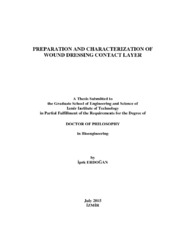Please use this identifier to cite or link to this item:
https://hdl.handle.net/11147/4470Full metadata record
| DC Field | Value | Language |
|---|---|---|
| dc.contributor.advisor | Bayraktar, Oğuz | - |
| dc.contributor.advisor | Atabey, Atay | - |
| dc.contributor.advisor | Başal Bayraktar, Güldemet | - |
| dc.contributor.author | Erdoğan, İpek | - |
| dc.date.accessioned | 2016-01-05T08:50:40Z | - |
| dc.date.available | 2016-01-05T08:50:40Z | - |
| dc.date.issued | 2015-07 | - |
| dc.identifier.citation | Erdoğan, İ. (2015). Preparation and characterization of wound dressing contact layer. Unpublished doctoral dissertation, İzmir Institute of Technology, İzmir, Turkey | en_US |
| dc.identifier.uri | http://hdl.handle.net/11147/4470 | - |
| dc.description | Thesis (Doctoral)--İzmir Institute of Technology, Bioengineering, İzmir, 2015 | en_US |
| dc.description | Full text release delayed at author's request until 2018.09.04 | en_US |
| dc.description | Includes bibliographical references (leaves: 73-80) | en_US |
| dc.description | Text in English; Abstract: Turkish and English | en_US |
| dc.description | xi, 97 leaves | en_US |
| dc.description.abstract | Wound dressings provide therapeutic and protective features and promotes natural healing process when applied to a wound area. Being non-toxic and immunologically inert, natural biopolymers have potential in fabrication of wound dressings. Growth factors and antibiotics can also be used in functionalization of wound dressings as well as plant extracts. Olive leaf extract has gained attraction due to its dual antimicrobial and antioxidant effect. By clearing pathogenic microorganisms and scavenging against increased amount of reactive oxygen species in the wound area, it has high potential in wound healing. In this study, olive leaf extract incorporated zein fibers were prepared as a model of wound dressing contact layer. In this regard, crude olive leaf extract was fractionated and characterized in terms of antioxidant capacity, total phenol content and antimicrobial activity. Crude extract and its fractions were also subjected to wound scratch assay in the presence of hydrogen peroxide. Oleuropein, as the most abundant component in crude extract, was found to promote cell migration better and close the wound area at a higher rate than other components. On the other hand, crude olive leaf extract exhibited higher percentage of wound closure than its fractions within the same time period, which may be attributed to synergistic effect of unidentified phenolics. Crude olive leaf extract also provided crosslinking effect when incorporated into zein fibers, as well as promoting cell spreading behaviour. | en_US |
| dc.description.abstract | Yara örtüleri terapötik ve koruyucu özelliklere sahip olup, yara bölgesine uygulandığında doğal iyileşme sürecini destekleyici görev yapmaktadırlar. Toksik olmamaları ve immunolojik bir reaksiyon yaratmamaları bakımından doğal polimerlerin yara örtüsü olarak kullanım potansiyelleri bulunmaktadır. Yara örtülerinin fonksiyonel hale getirilmesinde büyüme faktörleri ve antibiyotiklerin yanısıra bitki özütleri de kullanılmaktadır. Zeytin yaprağı özütü sahip olduğu ikili antimikrobiyal ve antioksidan etkisi sayesinde ilgi görmektedir. Yara bölgesindeki patojen mikroorganizmaların temizlenmesi ve artan miktardaki reaktif oksijen türlerinin süpürülmesinde rol oynaması nedeniyle yara iyileşmesinde önemli bir potansiyele sahiptir. Bu çalışmanın içeriğini bir yara örtüsü temas yüzeyi modeli olarak zeytin yaprağı özütü içerikli zein fiberlerinin hazırlanması oluşturmaktadır. Bu bağlamda, ham zeytin yaprağı özütü fraksiyonlanmış ve antioksidan kapasite, toplam fenol içeriği ve antimikrobiyal aktivitesi bakımından karakterize edilmiştir. Ham özüt ve fraksiyonları hidrojen peroksit varlığında yara modeli oluşturma çalışmalarında da kullanılmışlardır. Ham özüt içerisinde en yüksek miktarda bulunan oleuropeinin hücre göçünü en iyi destekleyen bileşen olduğu ve diğer bileşenlere oranla yara kapanmasını hızlandırdığı ortaya çıkarılmıştır. Diğer taraftan fraksiyonlanmamış ham özütün fraksiyonlarla karşılaştırıldığında hücre göçünü hızlandırdığı ve aynı zaman diliminde daha yüksek oranda yara kapanmasını sağladığı gözlenmiştir. Bu durumun özüt içinde bulunan tanımlanmamış fenolik bileşiklerin sinerjik etki göstermesine bağlı olduğu düşünülmektedir. Ham zeytin yaprağı özütü aynı zamanda zein fiberlere eklendiği zaman çapraz bağlama etkisi sağlamakta ve hücre yayılımına imkan sağlamaktadır. | en_US |
| dc.language.iso | en | en_US |
| dc.publisher | Izmir Institute of Technology | en_US |
| dc.rights | info:eu-repo/semantics/openAccess | en_US |
| dc.subject | Wound dressings | en_US |
| dc.subject | Surgical dressings | en_US |
| dc.subject | Polyphenols | en_US |
| dc.subject | Nanofibers | en_US |
| dc.subject | Bandages and bandaging | en_US |
| dc.title | Preparation and Characterization of Wound Dressing Contact Layer | en_US |
| dc.title.alternative | Yara örtüsü temas yüzeyi hazırlanması ve karaterizasyonu | en_US |
| dc.type | Doctoral Thesis | en_US |
| dc.institutionauthor | Erdoğan, İpek | - |
| dc.department | Thesis (Doctoral)--İzmir Institute of Technology, Bioengineering | en_US |
| dc.relation.publicationcategory | Tez | en_US |
| dc.identifier.wosquality | N/A | - |
| dc.identifier.scopusquality | N/A | - |
| item.languageiso639-1 | en | - |
| item.openairetype | Doctoral Thesis | - |
| item.cerifentitytype | Publications | - |
| item.openairecristype | http://purl.org/coar/resource_type/c_18cf | - |
| item.fulltext | With Fulltext | - |
| item.grantfulltext | open | - |
| crisitem.author.dept | 04.03. Department of Molecular Biology and Genetics | - |
| Appears in Collections: | Phd Degree / Doktora | |
Files in This Item:
| File | Description | Size | Format | |
|---|---|---|---|---|
| T001403.pdf | DoctoralThesis | 5.2 MB | Adobe PDF |  View/Open |
CORE Recommender
Page view(s)
476
checked on Jul 7, 2025
Download(s)
200
checked on Jul 7, 2025
Google ScholarTM
Check
Items in GCRIS Repository are protected by copyright, with all rights reserved, unless otherwise indicated.